算法进阶面试题03——构造数组的MaxTree、最大子矩阵的大小、2017京东环形烽火台问题、介绍Morris遍历并实现前序/中序/后序
接着第二课的内容和带点第三课的内容。
(回顾)准备一个栈,从大到小排列,具体参考上一课....
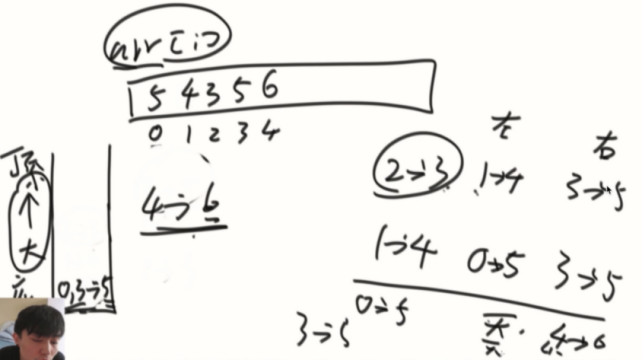
构造数组的MaxTree
【题目】
定义二叉树如下:
public class Node{
public int value;
public Node left;
public Node right;
public Node(int data){
this.value=data;
}
}
一个数组的MaxTree定义如下:
◆ 数组必须没有重复元素
◆ MaxTree是一颗二叉树,数组的每一个值对应一个二叉树节点
◆ 包括MaxTree树在内且在其中的每一颗子树上,值最大的节点都是树的头。
给定一个没有重复元素arr,写出生成这个数组的MaxTree函数,要求如果数组长度为N,则时间复杂度为O(N),额外空间复杂度为O(N)。
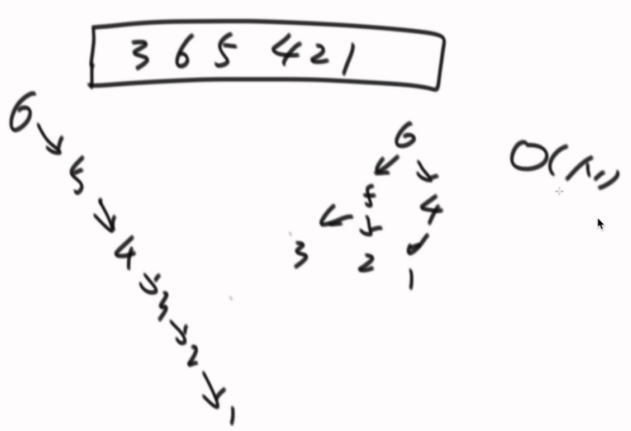
解法一:建出大根堆再重连成完全二叉树,o(n)
解法二:单调栈
1、左右都没比他大的节点就是头节点
2、对于有左右其中一边的,这个数就串在有的底下,3在4底下
3、对于左右都有的,挂在左右中较小的数下,2在3底下

为什么可行?
为什么不会形成森林?
数组中没有重复值,最大值肯定是头节点,任何节点都串在比他大的,都有归属,最终以最大值为头部,所以是一棵树。
会不会出现一个节点多个孩子的情况?
首先先证明在任意一侧只有一棵树挂在他底下。

反证法:假设b、c都挂在a底下。
b>c的话,不可能c还会挂在a底下,存在矛盾。
c>b的话,b也不可能挂在a下,会挂在c底下。

老师版本(分开设置左右临近的最大值)
//构造数组的MaxTree public class Code_02_MaxTree { //二叉树结点的定义如下 public static class Node { public int value; public Node left; public Node right; //结点的初始化 public Node(int data) { this.value = data; } } //构造数组的MaxTree函数 public static Node getMaxTree(int[] arr) { Node[] nArr = new Node[arr.length]; //存放二叉树结点的数组 for (int i = 0; i != arr.length; i++) { nArr[i] = new Node(arr[i]); } Stack<Node> stack = new Stack<Node>();//利用栈找出左右边第一个比自身大的数 HashMap<Node, Node> lBigMap = new HashMap<Node, Node>(); HashMap<Node, Node> rBigMap = new HashMap<Node, Node>(); //从第一个开始 // 找出所有数,左边第一个比自身大的数 for (int i = 0; i != nArr.length; i++) { Node curNode = nArr[i]; while ((!stack.isEmpty()) && stack.peek().value < curNode.value) { popStackSetMap(stack, lBigMap);//栈的一系列操作 } stack.push(curNode); } while (!stack.isEmpty()) { popStackSetMap(stack, lBigMap); } //从最后一个开始 // 找出所有数,右边第一个比自身大的数 for (int i = nArr.length - 1; i != -1; i--) { Node curNode = nArr[i]; while ((!stack.isEmpty()) && stack.peek().value < curNode.value) { popStackSetMap(stack, rBigMap);//栈的一系列操作 } stack.push(curNode); } while (!stack.isEmpty()) { popStackSetMap(stack, rBigMap); } Node head = null; //声明头结点 for (int i = 0; i != nArr.length; i++) { Node curNode = nArr[i]; Node left = lBigMap.get(curNode); Node right = rBigMap.get(curNode); //左右都空,证明他是最大的头节点 if (left == null && right == null) { head = curNode; } else if (left == null) {//左为空,就串在右的底下 if (right.left == null) {//从左到右 right.left = curNode; } else { right.right = curNode; } } else if (right == null) {//右为空,就串在左的底下 if (left.left == null) {//从左到右 left.left = curNode; } else { left.right = curNode; } } else { //选择左右较小的数为父节点 Node parent = left.value < right.value ? left : right; if (parent.left == null) {//从左到右 parent.left = curNode; } else { parent.right = curNode; } } } return head; } //栈的一系列操作 public static void popStackSetMap(Stack<Node> stack, HashMap<Node, Node> map) { Node popNode = stack.pop(); if (stack.isEmpty()) { map.put(popNode, null); } else { map.put(popNode, stack.peek()); //构造二叉树操作 } } //二叉树的先序遍历 public static void printPreOrder(Node head) { if (head == null) { return; } System.out.print(head.value + " "); printPreOrder(head.left); //递归调用遍历二叉树 printPreOrder(head.right); } //二叉树的中序遍历 public static void printInOrder(Node head) { if (head == null) { return; } printInOrder(head.left); System.out.print(head.value + " "); printInOrder(head.right); } public static void main(String[] args) { int[] arr = {3, 4, 5, 1, 2}; Node head = getMaxTree(arr); printPreOrder(head); System.out.println(); printInOrder(head); } }
自己码的版本(弹出一个数,同时设置其左右临近的最大值)
public class a03_01MaxTree { public static class Node { public int value; public Node left; public Node right; public Node(int data) { this.value = data; } } public static Node getMaxTree(int[] nodes) { Stack<Integer> stack = new Stack<Integer>(); HashMap<Integer, Integer> lLarge = new HashMap<Integer, Integer>(); HashMap<Integer, Integer> rLarge = new HashMap<Integer, Integer>(); for (int i = 0; i != nodes.length; i++) { while (!stack.isEmpty() && nodes[i] > nodes[stack.peek()]) { int index = stack.pop(); //谁让它弹出谁就是右边比他大的 rLarge.put(index, i); //再通过栈来设置左边的情况 if (stack.isEmpty()) { lLarge.put(index, null); } else { lLarge.put(index, stack.peek()); } } stack.push(i); } //把栈里面剩下的元素处理下 while (!stack.isEmpty()) { int index = stack.pop(); rLarge.put(index, null); if (stack.isEmpty()) { lLarge.put(index, null); } else { lLarge.put(index, stack.peek()); } } //形成Node数组 Node[] treeNodes = new Node[nodes.length]; for (int i = 0; i != nodes.length; i++) { treeNodes[i] = new Node(nodes[i]); } //建树 Node head = null; for (int i = 0; i != nodes.length; i++) { Integer lLargeIndex = lLarge.get(i); Integer rLargeIndex = rLarge.get(i); if (lLargeIndex == null && rLargeIndex == null) { head = treeNodes[i]; } else if (lLargeIndex == null) { if (treeNodes[rLargeIndex].left == null) { treeNodes[rLargeIndex].left = treeNodes[i]; } else { treeNodes[rLargeIndex].right = treeNodes[i]; } } else if (rLargeIndex == null) { if (treeNodes[lLargeIndex].left == null) { treeNodes[lLargeIndex].left = treeNodes[i]; } else { treeNodes[lLargeIndex].right = treeNodes[i]; } } else {//对比左右大小 Node parent = nodes[lLargeIndex] > nodes[rLargeIndex] ? treeNodes[rLargeIndex] : treeNodes[lLargeIndex]; if (parent.left == null) { parent.left = treeNodes[i]; } else { parent.right = treeNodes[i]; } } } return head; } //二叉树的先序遍历 public static void printPreOrder(Node head) { if (head == null) { return; } System.out.print(head.value + " "); printPreOrder(head.left); //递归调用遍历二叉树 printPreOrder(head.right); } //二叉树的中序遍历 public static void printInOrder(Node head) { if (head == null) { return; } printInOrder(head.left); System.out.print(head.value + " "); printInOrder(head.right); } public static void main(String[] args) { int[] arr = {3, 4, 5, 1, 2}; Node head = getMaxTree(arr); printPreOrder(head); System.out.println(); printInOrder(head); } }
最大子矩阵的大小
给定一个整型矩阵map,其中的值只有0,1两种,求其中全是1 的所有矩阵区域中,最大的矩形区域为1的数量。
例如:
1 1 1 0
其中最大的矩形区域有3个1,所以返回3
例如:
1 0 1 1
1 1 1 1
1 1 1 0
其中,最大的矩形区域有6个1,所以返回6
跳出这道题目,为了解决这个问题的一个引子题。
直方图找最大矩形

每个数都代表一个矩形,从第一个数开始尝试左右移动,碰到小的就停,例如4,面积就是4、3面积就是6....依次肯定会计算出最大的矩形。
利用单调栈,找到最近比他小的元素,弹出的时候,就可以计算出面积。
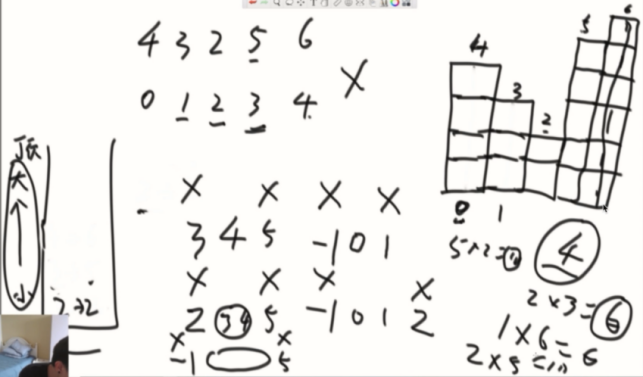
如果不是因为碰到比自己小的,全部元素过后,栈剩下的,就证明他们都能到达右边界(扩到5停)。
相等的情况:
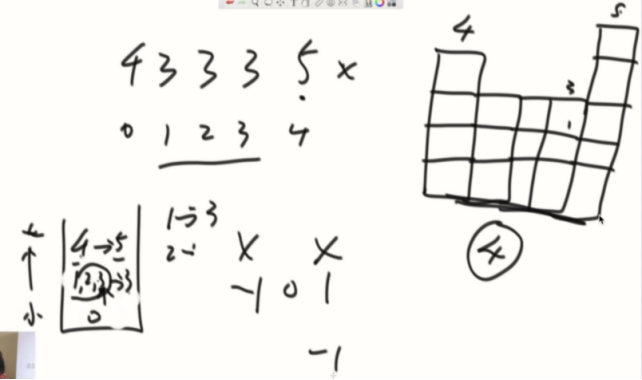
原始问题,完全借用了直方图的结论。
先看必须由第0行作为底,所有矩形中,哪个含有1是最多的。
接着看由第1行为底,每个位置,上面有多少个连续的1,然后通过这个计算结果,计算出哪个位置含1最多。
本次为0必为0,否则是之前的数再+1
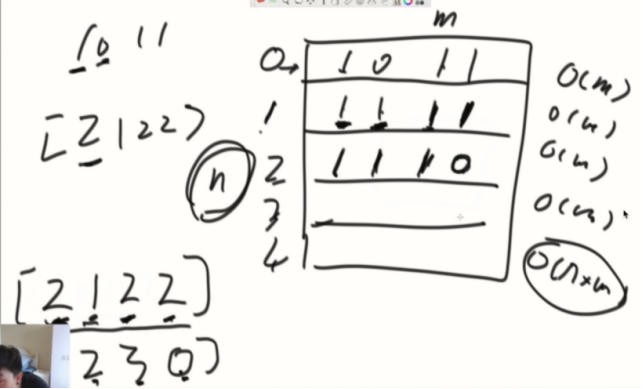
依次计算....
矩阵遍历一遍,o(n*m)搞定
代码解说:
public class Code_04_MaximalRectangle { //height数组表示在以当前行作为底的情况下,每个位置往上的连续的 1 的数量 public static int maxRecSize(int[][] map) { if (map == null || map.length == 0 || map[0].length == 0) { return 0; } int maxArea = 0; //辅助数组 int[] height = new int[map[0].length]; for (int i = 0; i < map.length; i++) { for (int j = 0; j < map[0].length; j++) { height[j] = map[i][j] == 0 ? 0 : height[j] + 1; } maxArea = Math.max(maxRecFromBottom(height), maxArea); } return maxArea; } //找到柱子左边刚比它小的柱子位置,以及右边刚比它大的柱子位置,用栈计算最快 //最基本的方法,如果一个数组表示直方图的话,在其中找到最大正方形 //例如:[4,3,2,5,6]代表一个直方图 private static int maxRecFromBottom(int[] height) { if (height == null || height.length == 0) { return 0; } int maxArea = 0; Stack<Integer> stack = new Stack<Integer>(); //遍历数组中的每一个数 for (int i = 0; i < height.length; i++) { //不断循环,直到当前位置的值小于栈顶元素 while (!stack.isEmpty() && height[i] <= height[stack.peek()]) { int j = stack.pop();//值 int k = stack.isEmpty() ? -1 : stack.peek();//左边界 int curArea = (i - k - 1) * height[j]; maxArea = Math.max(curArea, maxArea); } stack.push(i); } // 针对的是从栈底到栈顶一直递增的情况 //结算栈中剩下的东西 while (!stack.isEmpty()) { int j = stack.pop();//值 int k = stack.isEmpty() ? -1 : stack.peek();//左边界 int curArea = (height.length - k - 1) * height[j]; maxArea = Math.max(curArea, maxArea); } return maxArea; } public static void main(String[] args) { int[][] num = new int[][]{ {0,1,0,0,0,0}, {1,1,1,1,1,1}, {1,1,1,1,1,1}, {1,1,1,1,1,1}, {1,1,1,1,1,1} }; System.out.println(maxRecSize(num)); } }
2017年京东原题:烽火台
给一个数组,代表环形的山
1、每座山上会放烽火,相邻可看见烽火
2、不相邻的山峰,两条路中其中一条路上的烽火都不大于他们之间的最小值,就能看见
返回能相互看见的山峰有多少对?
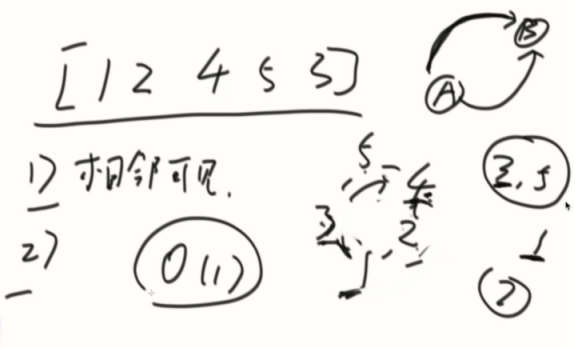

简单问法:数组值都不一样,o(1)。
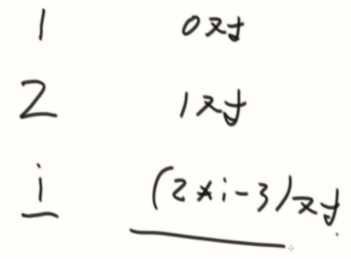
2*i-3对
证明:
把找法规定为:永远是小去找大。
3个数以及上,找到最高和次高,假设中间有一个值i,从i出发找大的,左边找到比i大的X停,右边找到Y停,就是两对。(最高和次高之间的每个数都能找到两个山峰对)
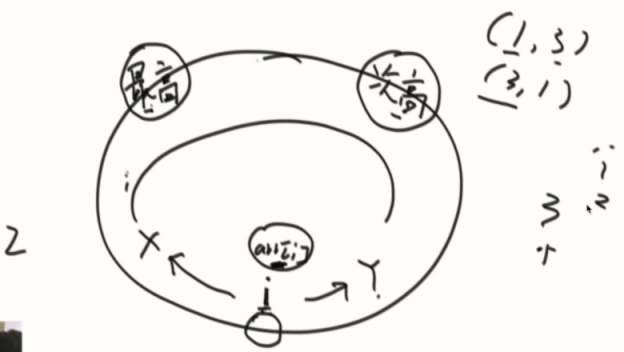
所以就是((n-(最高+次高))*2)+1(最高和次高那条)
((n-2)*2)+1 = 2n-4+1 = 2n-3条
有重复值的情况:单调栈
找到第一个最大值,开始往后遍历
加入碰到4,入栈,碰到5,开始出栈,因为底部是5,1(代表5出现了1次),所以对于4来说找到两对可以看见的山峰。接着底部5+1,变成5,2。
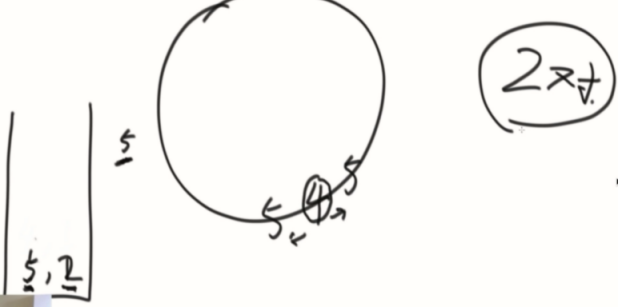
大体思路还是小的找大的。(换成4也同理)
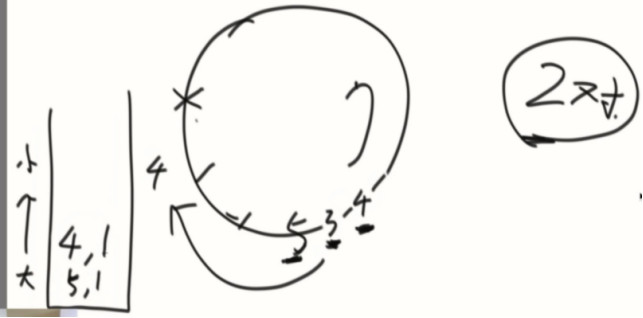
如果连续都是4,直到4,4碰上5,会产生两种互相看见的情况。
1、4和4之前相互看见,任意两个4都能相互看见,C42+4*2。
2、每个4左右边都能看见5,4*2。

用最大值打底的原因:在结算的过程中因为有这个最大值的出现,可以确定这个数的顺时针方向可以找到比他大的。
最后栈里面还有东西,需要结算。

三条及以上的还是用那个通式
如果底下是2以上,依旧是通式

如果底下只有1个5(两边遇到最大的是同一个5),计算变成:

所以,倒数第二的数要考虑,最大值的数量
最后一个数,比一大就是单纯的Ck2,如果只有一个就是0对。
public class Code_05_MountainsAndFlame { public static void main(String[] args) { Scanner in = new Scanner(System.in); while (in.hasNextInt()) { int size = in.nextInt(); int[] arr = new int[size]; for (int i = 0; i < size; i++) { arr[i] = in.nextInt(); } System.out.println(communications(arr)); } in.close(); } public static class Pair { public int value; public int times; public Pair(int v) { this.value = v; this.times = 1; } } private static long communications(int[] arr) { if (arr == null || arr.length < 2) { return 0; } int size = arr.length; int maxIndex = 0; for (int i = 0; i < size; i++) {//获得最大值的下标 maxIndex = arr[maxIndex] < arr[i] ? i : maxIndex; } int value = arr[maxIndex];//最大值 int index = nextIndex(size, maxIndex);//最大值位置的下一个 long res = 0L;//能互相看见的山峰数 Stack<Pair> stack = new Stack<Pair>(); stack.push(new Pair(value));//以最大值为底 while (index != maxIndex) {//转一圈 value = arr[index]; while (!stack.isEmpty() && stack.peek().value < value) { int times = stack.pop().times; // res += getInternalSum(times) + times; // res += stack.isEmpty() ? 0 : times; res += getInternalSum(times) + 2 * times; } if (!stack.isEmpty() && stack.peek().value == value) { stack.peek().times++;//相等的话累加 } else { stack.push(new Pair(value)); } index = nextIndex(size, index); } //跑完一圈后,结算栈里面剩下的 while (!stack.isEmpty()) { int times = stack.pop().times; //不管什么,肯定会内部产生山峰对 res += getInternalSum(times); if (!stack.isEmpty()) {//没到最后一个 res += times; if (stack.size() > 1) {//3个及以上的情况 res += times; } else {//第2个的情况,要结合最后一个数来判断 res += stack.peek().times > 1 ? times : 0; } } } return res; } //简单Ck(下标)2(上标) private static long getInternalSum(int n) { return n == 1L ? 0L : (long) n * (long) (n - 1) / 2L; } private static int nextIndex(int size, int i) { return i < (size - 1) ? (i + 1) : 0; } }
做这些就是为了进自己想进的任何公司,加油!
笔试分数会决定是否签合同,按部门挑人。
开始第三课的内容
1、介绍一种时间复杂度O(N),额外空间复杂度O(1)的二叉树的遍历方式,N为二叉树的节点个数
经典二叉树,无论递归还是非递归都逃不过,o(h)的额外空间复杂度,h为高度。

2、Morris遍历
利用Morris遍历实现二叉树的先序,中序,后序遍历,时间复杂度O(N),额外空间复杂度O(1)。
利用了底层空闲的空间,在学术上称为线索二叉树
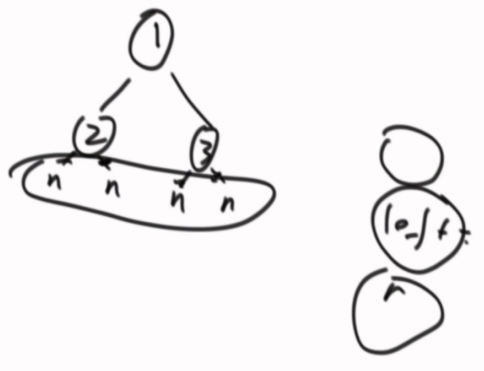
Morris遍历过程中的标准:
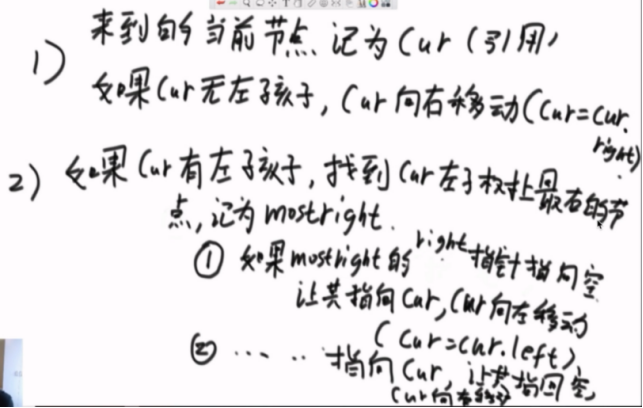
②...指向cur,让其指向空,cur向右移动
首先先忘掉什么前序中序后序遍历,这就叫Morris序
按标准走完全部流程。

看一下本质:
只要这个节点有左子树,就能回到这个节点两次,如果没有左子树,只到达这个节点一次。
当第二次来到这个节点的时候,左子树的节点一定全部遍历完。
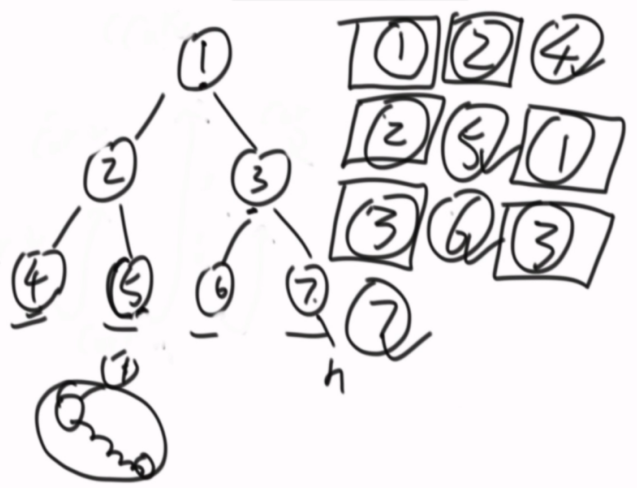
使用最右节点的右指针来标记,是第一次来到节点还是第二次来到。
不是完全二叉树也可以。
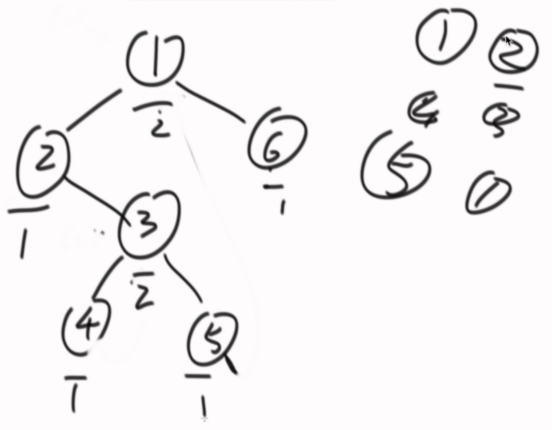
递归版本的遍历,会经过节点三次,打印时机在第一次就是先序,第二次中序,第三次后序。(最本质的是下面的遍历)
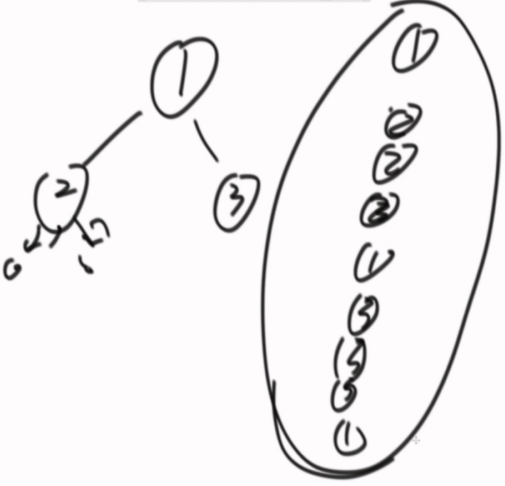
Morris,把第一次来到节点的时候打印,就是先序遍历。
打印时机放在最后一次来到这个节点的时候,就是中序遍历,例如一个节点有左子树,先把左子树处理完再打印,就是中序,当没有左子树的时候就直接打印(第一次和第二次重叠)。
怎么做到后序?
后序遍历只关心能到自己两次的节点,第二次到达节点的时候逆序打印左子树的右边界,打印完成后,在整个函数退出前,单独打印整课树的右边界,就是后序遍历。
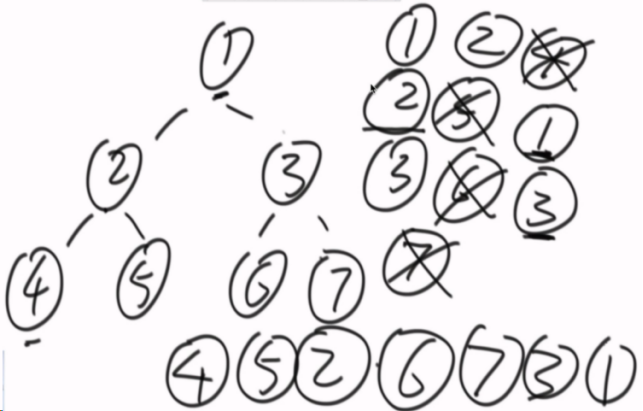
怎么逆序打印整棵树右边界?
用类似逆转链表的方式,把指针修改,打印完,再调整回去。

时间复杂度:
每次经过节点都打印右子树,都是有限的几次,所有复杂度还是O(N)
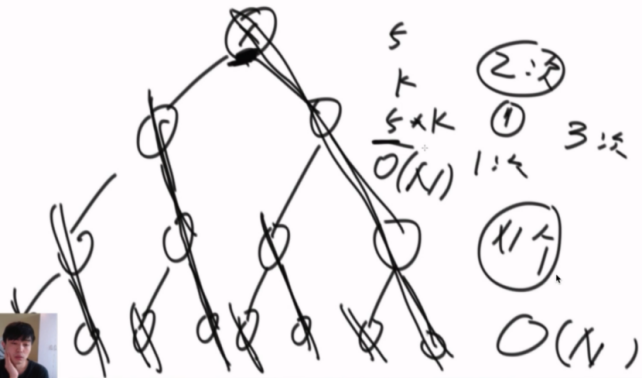
例子:
整颗左子树可以被右边界分解。每条右边界被遍历了两遍。右边界整体节点个数N个,被遍历有限几遍,一共O(N)。
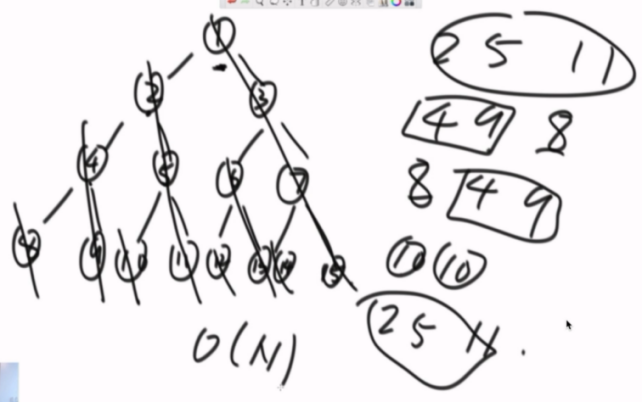
public class Code03_01_MorrisTraversal { //帮助理解Morris遍历 public static void process(Node head) { if (head == null) { return; } // 1 //System.out.println(head.value); process(head.left); // 2 //System.out.println(head.value); process(head.right); // 3 //System.out.println(head.value); } public static class Node { public int value; Node left; Node right; public Node(int data) { this.value = data; } } //中序遍历 public static void morrisIn(Node head) { if (head == null) { return; } Node cur = head; Node mostRight = null; while (cur != null) { mostRight = cur.left; if (mostRight != null) {//如果左孩子不等于空 //找到最右的节点,排除了null和cur的情况,能一直找下去 while (mostRight.right != null && mostRight.right != cur) { mostRight = mostRight.right; } if (mostRight.right == null) { mostRight.right = cur; cur = cur.left; continue; } else { mostRight.right = null; } } System.out.print(cur.value + " "); cur = cur.right; } System.out.println(); } //先序遍历 public static void morrisPre(Node head) { if (head == null) { return; } Node cur = head; Node mostRight = null; while (cur != null) { mostRight = cur.left; if (mostRight != null) { while (mostRight.right != null && mostRight.right != cur) { mostRight = mostRight.right; } if (mostRight.right == null) { mostRight.right = cur; System.out.print(cur.value + " "); cur = cur.left; continue; } else { mostRight.right = null; } } else {//当前节点没有左子树的时候,直接打印(中,左)再往右 System.out.print(cur.value + " "); } cur = cur.right; } System.out.println(); } //后序遍历 public static void morrisPos(Node head) { if (head == null) { return; } Node cur1 = head; Node cur2 = null; while (cur1 != null) { cur2 = cur1.left; if (cur2 != null) { while (cur2.right != null && cur2.right != cur1) { cur2 = cur2.right; } if (cur2.right == null) { cur2.right = cur1; cur1 = cur1.left; continue; } else {//第二次来的自己的时候 cur2.right = null; printEdge(cur1.left);//逆序打印左子树右边界 } } cur1 = cur1.right; } printEdge(head); System.out.println(); } public static void printEdge(Node head) { Node tail = reverseEdge(head); Node cur = tail; while (cur != null) { System.out.print(cur.value + " "); cur = cur.right; } reverseEdge(tail); } public static Node reverseEdge(Node from) { Node pre = null; Node next = null; while (from != null) { next = from.right; from.right = pre; pre = from; from = next; } return pre; } // for test -- print tree public static void printTree(Node head) { System.out.println("Binary Tree:"); printInOrder(head, 0, "H", 17); System.out.println(); } public static void printInOrder(Node head, int height, String to, int len) { if (head == null) { return; } printInOrder(head.right, height + 1, "v", len); String val = to + head.value + to; int lenM = val.length(); int lenL = (len - lenM) / 2; int lenR = len - lenM - lenL; val = getSpace(lenL) + val + getSpace(lenR); System.out.println(getSpace(height * len) + val); printInOrder(head.left, height + 1, "^", len); } public static String getSpace(int num) { String space = " "; StringBuffer buf = new StringBuffer(""); for (int i = 0; i < num; i++) { buf.append(space); } return buf.toString(); } public static void main(String[] args) { Node head = new Node(4); head.left = new Node(2); head.right = new Node(6); head.left.left = new Node(1); head.left.right = new Node(3); head.right.left = new Node(5); head.right.right = new Node(7); printTree(head); morrisIn(head); morrisPre(head); morrisPos(head); printTree(head); } }
以后但凡遇见能用遍历解的面试题,都是扯Morris遍历,就会让面试官高看你一眼!(把别人弄掉,你自己上)
作者: kent鹏
出处: http://www.cnblogs.com/xieyupeng/
关于作者:专注JAVAEE领域,请多多赐教!
本文版权归作者和博客园共有,欢迎转载,但未经作者同意必须保留此段声明,且在文章页面明显位置给出原文链接。




